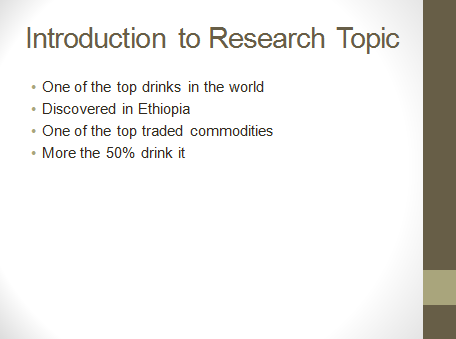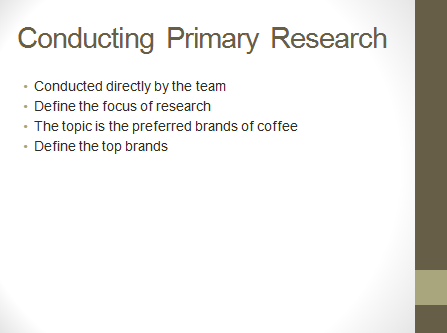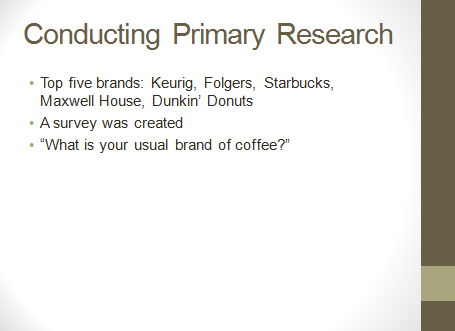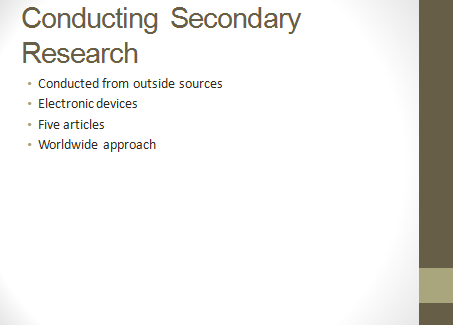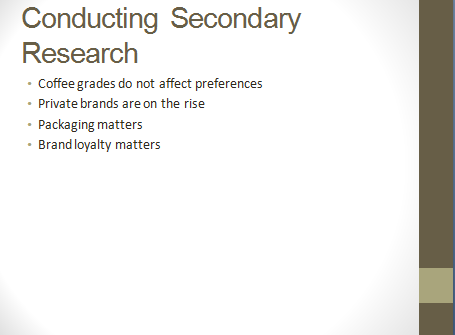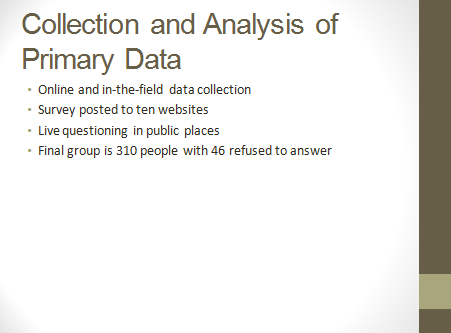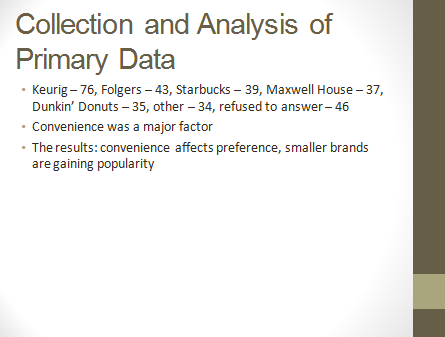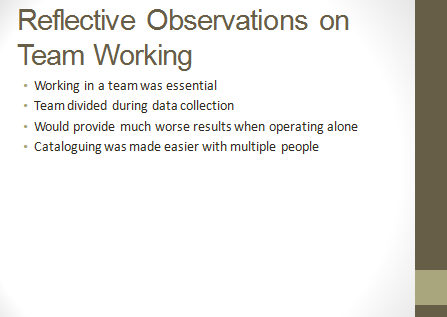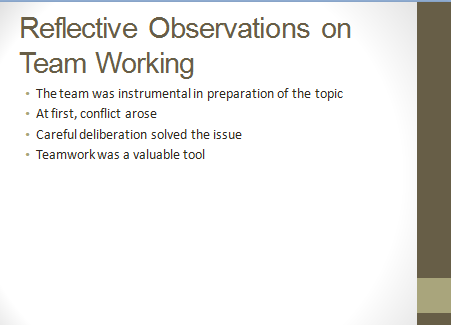Introduction
Modern life, as well as many good mornings, is hard to imagine without a cup of coffee. Being discovered in Ethiopia around 800 AD, coffee is one of the most popular beverages preferred by people around the whole world. There are multiple choices of occupations where coffee makers are required, and in many offices, a coffee machine turns out to be an important attribute. In cities, it is hard to count the actual number of special coffee machines and shops available to people.
Coffee is one of the most famous fair trade products regarding people involved in its production, the number of products offered to people, and sales volume it presents (van Loo et al. 2015). Though not all people may like coffee, almost all of them are able to recognise its smell and nature. This project aims at discussing the existing consumer preferences for coffee, evaluating the work of well-known coffee makers, and analysing coffee choices of people.
Some people cannot star their days without a cup of coffee, and some people try to avoid its usage because of its possible impact on the heart. Still, the coffee industry continues developing and becomes a good example for other commodity groups to be followed, and its analysis helps to comprehend consumer preferences.
Literature Review
Coffee consumers have access to many different brands and flavours in regard to which they can choose their morning moods, afternoon energy, and evening inspiration (Jones 2015). As a rule, each brand has certain blends and varieties, and preferences for coffee may be influenced by different factors, including price, demographics, and ethnicity (Jones 2015; Kobayashi and Benassi 2015).
Price sensitivity is one of the main issues consumers have to consider when they decide to use coffee, and price depends on a number of factors. For example, the coffee price may be presupposed by the type of tree used, the altitude of production, the score of the quality, and even the size of the lot offered (Jones 2015). Price is one of the first things people consider when they decide to buy a coffee product. There are many private and public brands that can be offered to people with different social statuses and income levels (Jones 2014).
At the same time, companies do not want to underline their intentions to divide their production because of poverty or some people’s inabilities. Coffee consumers may be too sensitive, and coffee developers, as well as the representatives of the coffee marketing field, try to avoid these themes and identify other important issues that influence consumer preferences.
Each author offers new approaches and understandings of the coffee industry proving the emergence of a growing interest in the coffee industry development. For example, Giacalone et al. (2016) admit that quality grades should not influence consumer preferences. Consumers have their own reasons to buy or not to buy coffee packs. People may or may not want to drink coffee regularly. Some people like to visit special coffee shops to enjoy a true taste of coffee, and some people find it enough to buy a cheap pack of coffee and drink a cup every morning.
Kobayashi and Benassi (2015) say about the role of packaging as another important thing people pay attention to during their first contacts. Sometimes, people cannot even guess that they make a choice of a coffee pack in case there is or is not a cup of coffee with foam. Some people like to see coffee beans on packs as the recognition of the basics and the possibility to prove people the naturalness of the offered product. In addition to a general look of a coffee pack or a glass jar, people may want to observe their forms and the colour of the material offered (Kobayashi and Benassi 2015).
The place where a coffee product can be found plays an important role as well. Comparing one or two packs or jars on a market shelf with a specially created shelf with several coffee cups or real coffee beans, the second option can attract the attention of people. Still, the results of such marketing move may vary because customers’ intentions are hard to predict.
There is also a possibility to shift consumers’ preferences by means of the quality and the amount of information offered to consumers (Jones 2014). People want to have as much information as possible about coffee shops, products, and services available to them. For example, the citizens of Taiwan rely on the power of a brand image and prefer the production of such company as Starbucks despite such factors as quality or price (Yang et al. 2015). The authors believe that the improvement of market understanding and the intentions to increase the generalisability can help to change consumers’ perceptions and make people recognise new brands, other coffee shops, and multiple alternatives available today (Yang et al. 2015).
Recent investigations show that many organisations focus on the quality of products and beverages. However, coffee is consumed by more than 54% of Americans and 63% of Canadians, but it is not water and cannot be defined as a drink of necessity (Jones 2015). There are certain standards to be followed while producing a brand, and people should develop their preferences on such factors as quality and appropriateness in regard to person’s health conditions. Van Loo et al. (2015) suggest focusing on sustainability labels as the tools with the help of which consumers can analyse their opportunities and choose drinks that are more appropriate to them.
Methodology
There are two types of methods chosen by the researchers to discuss the topic of consumer preferences for coffee and recognise the brand that is frequently used by ordinary people. The researchers chose a quantitative method of data collection as a part of primary research and the review of past research as the main method of secondary research. Both approaches helped to introduce a clear picture of what people thought about coffee and what their preferences could be based on.
In the beginning, quantitative research was conducted to investigate the preferences of consumers. Survey methodology was used to gather the opinions of different people about the brands of coffee they preferred. The main survey data collection technique was a questionnaire with one simple question to be answered: “What is your usual brand of coffee?”. Five options were offered to the participants, including the well-known brands.
To create the list of question, it was necessary to investigate the latest online reports and forums. Such brands as Keurig (famous coffee pods), Folgers (well-known large quantities), Starbucks (attractive coffee shops), Maxwell House (instant services), and Dunkin’ Donuts (tasty cakes in addition to coffee) were offered for the participants of the survey. Besides, there was a section that included personal comments in case the participants wanted to share their own experiences, tastes, and options. “Other” section was offered in case the participants had other coffee brands to be chosen. The survey aimed at gaining original information from ordinary people.
The surveys were offered online and on the street. People were asked to participate in a short questionnaire. It was important to provide them with confidentiality and anonymity. It did not take much time to gather the opinions. In general, approximately 350 people were invited to participate in the survey.
The next step in gathering the material was the development of the secondary data collection method. It was decided to develop a review of research done during the last years and identify what people discovered in the coffee industry and consumer preferences, in particular. Secondary research methods helped to find several credible sources online using such tools as Google Scholar. Two criteria were met: the topic of research “consumer perceptions for coffee” and the age of publications (no older than five years).
A global perspective was used to gather secondary information. It was necessary to gather the opinions of researchers from different parts of the world to identify if demographic or geography could determine the quality and frequency of consumer perceptions and preferences for coffee. There are the communities where national brands of coffee are preferred, and there are people who like to use the brands of local developers. Secondary data research was the possibility to find out the investigations in different countries, like Taiwan, Canada, and the United States. Consumers have a great power in the coffee industry, and the task of the researchers of this project was to gather as much primary and secondary information as possible in a short period of time.
Primary Data Analysis
A survey was the main method of data collection. It was necessary to involve as many participants as possible to find the answer to the main question that is the most preferred brand of coffee. The survey was organised online and on the street. People were invited to participate. Out of 356 people, 310 were ready to cooperate and share their opinions. 46 people refused to answer the question because they did not want to talk, did not have time to communicate, or could not choose their preferred brand. Therefore, the analysis of primary data was based on the answers given by 310 people online and in-the-field. The messages with a survey question were sent to people via ten different sources, and in-the-field research was based on communication at public places with randomly chosen people.
The analysis of the data was organised in a simple way: the questions of all participants were counted and divided in accordance with the coffee brands identified. The investigation of the latest reports on famous coffee brands worldwide was approved because the majority of the participants chose Keurig as their favourite coffee brand (76 supportive responses). 43 participants supported Folgers, and 39 people preferred Starbucks.
Maxwell House was chosen by 37 participants, and Dunkin’ Donuts was the choice of 35 people. 34 people had their own brands as preferred ones. As it was mentioned, 46 people refused to participate in research. During the analysis of the data, it was discovered that convenience and personal preference were two main factors for choosing a coffee brand. The responses were calculated manually, and the researchers combined the answers of survey participants with the secondary data gathered from the chosen articles and reports.
The results of primary data collection show that Keurig is the coffee brand preferred by many people due to its convenience. The comments left by some participants helped to comprehend that coffee choices had a certain connection with the factor of convenience. There is no need for a brand to be popular in different countries or huge in its size. Convenience is the reason for why people can make their choices and explain their preferences. People do not want to wait too much to get their coffee cup. If their coffee requires a complex preparation process, or some differences can be observed, negative correlations are developed, and preferences disappear.
The analysis of the answers and communication with people prove that convenience turns out to be the main factor of consumer preferences for coffee. It is a dependent variable, and its changes may be explained by human attitudes, wishes, and price. There are all chances for small brands to be chosen by consumers in case appropriate conditions, fast services, and availability can be observed. Convenience is that many people strive for in their lives, and if someone’s convenience should begin with a properly chosen cup of coffee, this research can be a significant contribution for all coffee fans and those who think about choosing a good cup of coffee.
Conclusions
In this project, the goal is to understand what coffee brand is preferable to people, and what factors may contribute the choice of people. The review of the literature shows that people may pay attention to different factors, including a general look, a method of preparation, a level of popularity, or even the way a coffee product is presented. Each factor has enough backgrounds and reasons to be recognised as a crucial point, and people are free to share their own interests, knowledge, and preferences.
The peculiar feature of this research is a properly chosen research method. A survey helped to gather the opinions of different people through several online sources and under in-the-field conditions. Direct communication and the possibility to use statistical data were appropriate tools for data gathering. All participants were provided with confidentiality and anonymity. Besides, they could withdraw a research process at any stage. No persuasion or threats were applicable to the participants from the researcher’s side.
The results of the work done could be used for the development of an independent investigation or as the basis for new research. The work proved the importance of convenience in coffee consumption. It is also necessary to improve market understanding of the convenience evaluation and identify what steps have to be taken to improve the situation and help people recognise new factors for their preferences for coffee. The development of the coffee industry proves that consumer perceptions can vary because of different reasons, and coffee developers have all opportunities to gather new material, to investigate customers’ interests, and to make the conclusions with the help of which coffee marketing can be beneficial for companies and effective for consumers.
Reflective Observations on Team Working
The success of this project is predetermined by the possibility of people to work in a team and divide the work in accordance with the tasks and people’s abilities. The team was instrumental in the preparation of the topic, data gathering, and analysis. One of the most challenge tasks was the identification of the topic and the choice of an appropriate focus. A certain time was spent on thoughtful discussions, academic research, and finding the solution.
Though all team members had different opinions and approaches on how to gather the material, one common solution was made due to the ability to listen to each other and understand the importance of the work instead of thinking about personal benefits. The conflict of interest was an integral part of the work. Still, to find a solution was the main goal of team working, and it was successfully achieved. Careful deliberation and the possibility to listen to each other were helpful for all participants of this project.
Many topics were discussed and investigated to come to the same conclusion and define the scope of the study. It was decided to address a test group with certain people who shared their opinions and developed a coherent test to make a final decision. The results of the work that was done prove an appropriateness of the directions chosen. Communication, mutual trust, and knowledge exchange promoted the development of team working.
In general, students’ skills and intentions, and the level of commitment, it is possible to say that teamwork turns out to be a significant and valuable tool in this project. This kind of work helped to cover the chosen topic and motivate different people to work together and achieve positive results.
Reference List
Giacalone, D., Fosgaard, T., Steen, I., Münchow, M., 2016. Quality Does not Sell Itself: Divergence between Objective Product Quality and Preference for Coffee in Naïve Consumers. British Food Journal, 118 (10), 2462-2474.
Jones, E. 2014. Consumer Preferences for National Brands and Private Labels: Do Business Cycles Matter? National Brands and Private Labels in Retailing, 1, 91-101.
Jones, E. 2015. Consumer Preferences for Coffee: Hot and Wet, or Quality and Flavor?’ Journal of Food Products Marketing, 22, (3), 350-380.
Kobayashi, M. and Benassi, M., 2015, Impact of Packaging Characteristics on Consumer Purchase Intention: Instant Coffee in Refill Packs and Glass Jars. Journal of Sensory Studies, 30 (3), 169-180.
van Loo, E.J., Caputo, V., Nayga, R.M., Seo, H.S., Zhang, B., Verbeke, W., 2015. Sustainability Labels on Coffee: Consumer Preferences, Willingness-to-Pay and Visual Attention to Attributes. Ecological Economics, 118, 215-225.
Yang, C. Paoching, C., Lin, S., Rofiq, M., Davaanyam, O., 2015. The Brand Perception Influence on Coffee Consumption: A Case Study of the Chain Stores Starbucks and 85°C Daily Cafe in Taiwan. International Journal of Science and Engineering Investigations, 4 (42), 65-68.
Appendix
